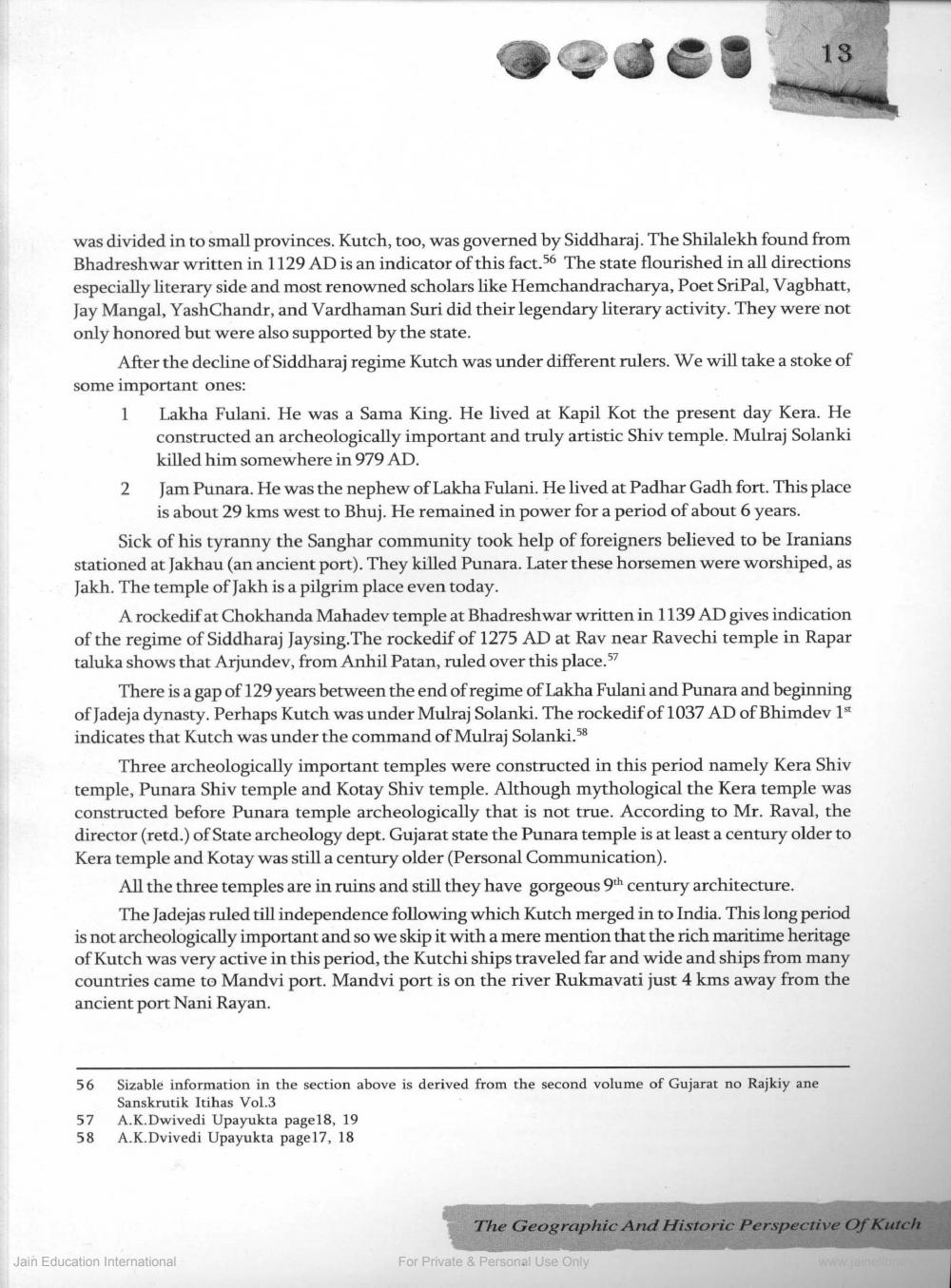________________
was divided in to small provinces. Kutch, too, was governed by Siddharaj. The Shilalekh found from Bhadreshwar written in 1129 AD is an indicator of this fact.56 The state flourished in all directions especially literary side and most renowned scholars like Hemchandracharya, Poet Sri Pal, Vagbhatt, Jay Mangal, YashChandr, and Vardhaman Suri did their legendary literary activity. They were not only honored but were also supported by the state.
After the decline of Siddharaj regime Kutch was under different rulers. We will take a stoke of some important ones: 1 Lakha Fulani. He was a Sama King. He lived at Kapil Kot the present day Kera. He
constructed an archeologically important and truly artistic Shiv temple. Mulraj Solanki
killed him somewhere in 979 AD. 2 Jam Punara. He was the nephew of Lakha Fulani. He lived at Padhar Gadh fort. This place
is about 29 kms west to Bhuj. He remained in power for a period of about 6 years. Sick of his tyranny the Sanghar community took help of foreigners believed to be Iranians stationed at Jakhau (an ancient port). They killed Punara. Later these horsemen were worshiped, as Jakh. The temple of Jakh is a pilgrim place even today.
A rockedif at Chokhanda Mahadev temple at Bhadreshwar written in 1139 AD gives indication of the regime of Siddharaj Jaysing. The rockedif of 1275 AD at Rav near Ravechi temple in Rapar taluka shows that Arjundev, from Anhil Patan, ruled over this place. 57
There is a gap of 129 years between the end of regime of Lakha Fulani and Punara and beginning of Jadeja dynasty. Perhaps Kutch was under Mulraj Solanki. The rockedif of 1037 AD of Bhimdev 1st indicates that Kutch was under the command of Mulraj Solanki.58
Three archeologically important temples were constructed in this period namely Kera Shiv temple, Punara Shiv temple and Kotay Shiv temple. Although mythological the Kera temple was constructed before Punara temple archeologically that is not true. According to Mr. Raval, the director (retd.) of State archeology dept. Gujarat state the Punara temple is at least a century older to Kera temple and Kotay was still a century older (Personal Communication).
All the three temples are in ruins and still they have gorgeous 9th century architecture,
The Jadejas ruled till independence following which Kutch merged in to India. This long period is not archeologically important and so we skip it with a mere mention that the rich maritime heritage of Kutch was very active in this period, the Kutchi ships traveled far and wide and ships from many countries came to Mandvi port. Mandvi port is on the river Rukmavati just 4 kms away from the ancient port Nani Rayan.
56
Sizable information in the section above is derived from the second volume of Gujarat no Rajkiy ane Sanskrutik Itihas Vol.3 A.K.Dwivedi Upayukta page18, 19 A.K.Dvivedi Upayukta page 17, 18
57 58
The Geographic And Historic Perspective of Kutch
Jain Education International
For Private & Personal Use Only




